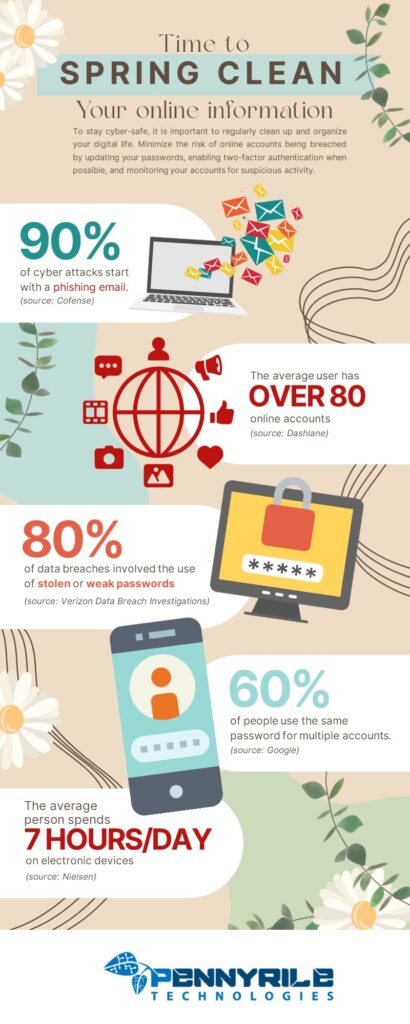Cybersecurity Spring Cleaning
Spring is the perfect time to clean out your business, get rid of clutter and start fresh. One important aspect of this is to make sure your technology passwords and accounts are secure.
Business owners may overlook this step in their cybersecurity spring cleaning, but it’s essential to ensure the safety of their sensitive information.
5 Key reasons why small business owners should prioritize spring cleaning their technology passwords and accounts.
1. Security Breaches are on the Rise
As technology becomes more advanced, so do the methods used by hackers to breach security systems. Small businesses are at risk of cyber-attacks. Weak passwords and outdated security measures can make them vulnerable. Updating passwords and securing accounts can help protect against potential security breaches.
2. Protect Confidential Information
Your business has a lot of confidential information, such as customer data and financial records. If this information falls into the wrong hands, it can be damaging to the business, and to its reputation. By ensuring that passwords and accounts are secure, small business owners can prevent unauthorized access to sensitive information.
3. Compliance with Regulatory Requirements
Many industries have specific regulatory requirements for data protection and security, such as the General Data Protection Regulation (GDPR) or the Payment Card Industry Data Security Standard (PCI DSS). Regularly updating passwords helps small businesses remain compliant with these regulations and avoid potential penalties or legal issues.
4. Improve Productivity
Outdated and forgotten passwords can cause significant delays and reduce productivity if access is difficult to obtain. Employees may spend hours trying to reset passwords or access accounts. By ensuring that passwords are up-to-date and easily accessible, small business owners can improve their team’s productivity.
5. Password Management Efficiency
Over time, businesses may accumulate numerous accounts and passwords, making it challenging to manage and remember them all. By spring cleaning passwords, businesses can streamline their password management practices, making it easier to keep track of and maintain secure access to various accounts.
We know that keeping our accounts clean is important, but how should you go about spring-cleaning your technology passwords and accounts?
1. Start With a Security Audit
You should perform a security audit to identify potential vulnerabilities in your accounts and technology. This can include reviewing access logs, checking security settings, and updating software and firmware to
the latest versions.
2. Review Your Existing Passwords
Use strong, unique passwords. It’s essential to use strong passwords that are difficult to guess. This means using a combination of upper and lowercase letters, numbers, and symbols. Additionally, each account should
have a unique password to prevent a breach of one account leading to access to all accounts.
3. Add an Additional Layer of Security
Two-factor authentication provides an extra layer of security to accounts by requiring a second form of verification before allowing access. This can include a code sent to a mobile device or biometric
authentication like fingerprint or facial recognition.
4. Schedule Ongoing Maintenance
Update passwords regularly. It’s a good practice to update passwords every few months to ensure
their effectiveness. This can prevent unauthorized access by someone who may have gained access to an old password.
5. Password Managers
A password manager is a tool that can help to manage and secure passwords. These tools can create and store complex passwords, so users don’t have to remember them. Some password managers even offer features like
alerts when a password has been breached, so you can update the password immediately.
6. Protection Against Insider Threats
Spring cleaning passwords should also include reviewing and revoking access to accounts and systems for former employees or individuals who no longer require access. This helps prevent unauthorized individuals from accessing sensitive information and protects against potential insider threats.
7. Business Continuity Planning
Asses the organization’s incident response plan, including processes for detecting, responding to, and recovering from security incidents. Review business continuity and disaster recovery plans to ensure systems can be restored and operations can resume in the event of a disruption or incident. Don’t have a plan in place? Time to make one!
8. Don’t Forget Physical Security
This aspect of an audit focuses on physical security controls, such as access controls, video surveillance, and environmental safeguards (e.g., temperature control, fire suppression) within data centers, server rooms, or other critical IT infrastructure locations.
9. Conduct Regular Cybersecurity Training
Cybersecurity training for employees at your organization can play a vital role in keeping your business safe from cyber threats. Training employees on how to recognize phishing emails, suspicious links, and other common cyber threats significantly reduces the chances of successful cyber attacks. This proactive approach minimizes potential breaches.
Cybersecurity Spring Cleaning Conclusion
You should start spring cleaning your technology passwords and accounts to ensure the safety of your business’s sensitive information. If you’re already a client, let’s get this on the calendar today, and if you’d like to learn more, contact us for a free consultation.




